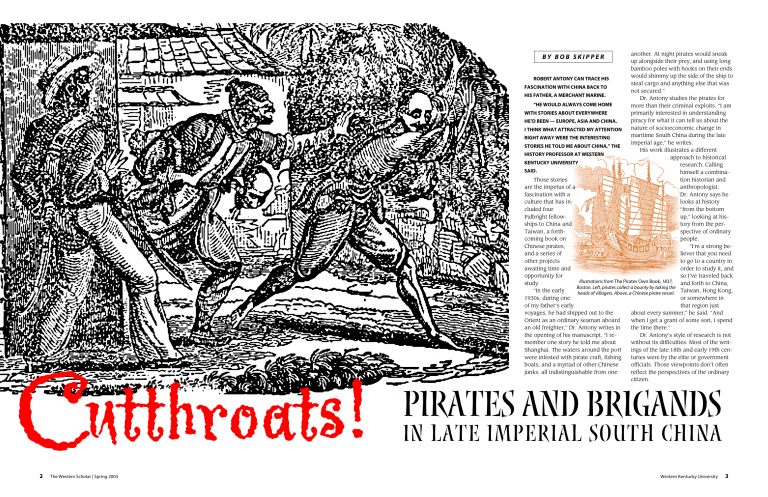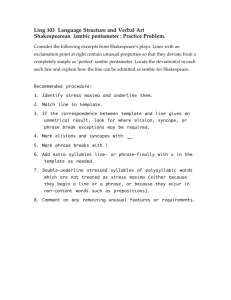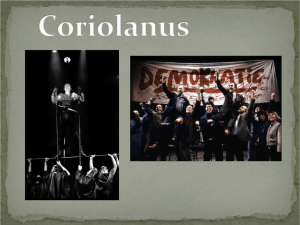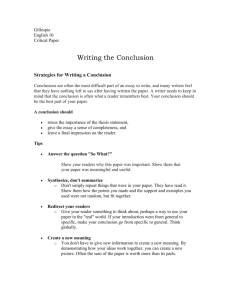Document 14111646
advertisement

another. At night pirates would sneak up alongside their prey, and using long bamboo poles with hooks on their ends would shimmy up the side of the ship to ROBERT ANTONY CAN TRACE HIS steal cargo and anything else that was FASCINATION WITH CHINA BACK TO not secured.” HIS FATHER, A MERCHANT MARINE. Dr. Antony studies the pirates for “HE WOULD ALWAYS COME HOME more than their criminal exploits. “I am WITH STORIES ABOUT EVERYWHERE primarily interested in understanding piracy for what it can tell us about the HE’D BEEN — EUROPE, ASIA AND CHINA. nature of socioeconomic change in I THINK WHAT ATTRACTED MY ATTENTION maritime South China during the late RIGHT AWAY WERE THE INTERESTING imperial age,” he writes. STORIES HE TOLD ME ABOUT CHINA,” THE His work illustrates a different HISTORY PROFESSOR AT WESTERN approach to historical KENTUCKY UNIVERSITY research. Calling SAID. himself a combinaThose stories tion historian and are the impetus of a anthropologist, fascination with a Dr. Antony says he culture that has inlooks at history cluded four “from the bottom Fulbright fellowup,” looking at hisships to China and tory from the perTaiwan, a forthspective of ordinary coming book on people. Chinese pirates, “I’m a strong beand a series of liever that you need other projects to go to a country in awaiting time and order to study it, and opportunity for so I’ve traveled back Illustrations from The Pirates Own Book, 1837, study. and forth to China, Boston. Left, pirates collect a bounty by taking the “In the early heads of villagers. Above, a Chinese pirate vessel. Taiwan, Hong Kong, 1930s, during one or somewhere in of my father’s early that region just voyages, he had shipped out to the about every summer,” he said. “And Orient as an ordinary seaman aboard when I get a grant of some sort, I spend an old freighter,” Dr. Antony writes in the time there.” the opening of his manuscript. “I reDr. Antony’s style of research is not member one story he told me about without its difficulties. Most of the writShanghai. The waters around the port ings of the late 18th and early 19th cenwere infested with pirate craft, fishing turies were by the elite or government boats, and a myriad of other Chinese officials. Those viewpoints don’t often junks, all indistinguishable from one reflect the perspectives of the ordinary citizen. BY BOB SKIPPER utthroats! C 2 The Western Scholar | Spring 2003 Pirates and Brigands in Late imperial south China Western Kentucky University 3 Dr. Robert Antony A pirate attack from the illustrated journal Renjing Huabao, 1907, Shanghai A Taoist Exorcist Sword Dance, witnessed by Dr. Antony February 2002 in Shalun village, northern Taiwan. It was performed by two “barefoot Taoist masters” as part of the birthday celebration for the community’s patron deity named “Patriarch of the Clear Stream,” a Taoist cosmic warrior god. 4 An incense burner in the Mazu Temple in Danshui, northern Taiwan. Mazu, a female deity, is the patron deity of sailors , and one of the most popular in Taiwan. The Western Scholar | Spring 2003 For example, Dr. Antony recently returned from a year-long sabbatical in Taiwan on his fourth Fulbright research grant. While there, he was a Visiting Research Fellow at the Institute of Taiwan History at Academia Sinica and a Visiting Scholar at the Center for Chinese Studies at Taiwan’s National Library. His research was on “Passion, Sex and Violence on the Taiwan Frontier in the Qing Dynasty,” a look at the impact of frontier culture on sexuality and gender relations. His topic was a combination of women’s studies and a look at the frontier culture in 18th century Taiwan. The idea came from a study of the American West and its frontier culture. While some researchers have been studying the impact that American frontier culture had on gender relations, no one was looking at the Chinese frontier and its impact on gender relations. “So I thought that would be a really interesting topic. As it turns out it was an interesting topic,” Dr. Antony said. “After I got to Taiwan, however, I found there were not that many primary materials on the topic. No one had really written about it. I found things about women, but nothing really explaining how the frontier affected the gender relationship.” “None of the officials, the people who were writing back in the 18th century, were writing about women’s problems,” he said. “That wasn’t considered important to them.” Violence, however, was a major topic. Officials were concerned with violence on the frontier, especially in the “civilizing” of the native Aborigines. “I found a lot of information on the conflicts between the Chinese settlers or frontiersmen and those indigenous people,” he said. “So what began as a study of passion, sex and violence, turned out to be more of a study of violence.” And while the study of gender relationships is still a viable topic that will take more time, Dr. Antony refocused his attention on violence, looking at bandits, secret societies, rebellions and, once again, pirates. “As I was getting into it, I was drawn further and further into Chinese popular religion and the relationship between religion, popular religion or folk religion, and some of these rebellious movements in A depiction of the sea goddess Mazu from a pirate flag of the late 19th–early 20th century. Western Kentucky University 5 Taiwan and South China,” he said. “My studies have evolved over time according to the sources I have had access to there.” This also fits well with research Dr. Antony has begun into secret societies, such as the Triads. These societies were involved in a number of activities from banditry to prostitution to gambling, and were the source of rebellions against the Chinese leadership. “In a number of these movements, I found that there were these ‘preachers’ or shamans who went around the countryside stirring up people to follow them,” he said. “In some cases they were nothing more than charlatans, and other times they were genuine magicians or wizards or shamans who said they could cure illnesses by their charms. One of the things that upset the government was that sometimes they stirred up uprisings and rebellions.” Many of these shamans preached the coming of demons or another Buddha. “What they were preaching was the destruction of the world,” he said. “Of course this upset the government very much because they were a part of the world order and many of the aims of these shamans, these wizards, were against the government. This is why we have lots of records about them in the archives because the government paid a lot of attention to these people. I’m interested in what they were preaching and why people were following them.” Dr. Antony said most people study the three great religions: Buddhism, Taoism, and Confucianism. “But there’s also a fourth religion in China, the folk religion, which the ordinary people follow,” he said. Many of the rebel movements that tried to overthrow governments in China throughout history were led by these folk religion leaders, or shamans, and there are some parallels with the government’s handling of religions today, he said. “There’s the sense that the government has to be careful with these movements.” Take the Yi Guan Dao, a religious movement that goes back to the beginning of the 20th century and earlier. It is considered an illegal religion in Mainland China and suppressed. “In Taiwan, on the other hand, it was looked What [these shamans] were preaching was the destruction of the world. This is why we have lots of records about them in the archives because the government paid a lot of attention to these people. A pirate battle from the Illustrated journal Dianshi Zhai Huabao, 1884, Shanghai 6 The Western Scholar | Spring 2003 Lanshin Antony, a native of Taiwan, often accompanies her husband on field research and acts as a translator. upon earlier as a secret religion and also suppressed,” he said, “but in recent years because the membership has expanded and become a more powerful institution in Taiwan, it has become legalized and has built up close connections within the government and community and within the economic structure of Taiwan. Now it’s above ground, a legal religion on Taiwan.” Of particular interest to Dr. Antony is a Triad rebellion in 1802 lead by the Hakka, a group of late-comers in Guangdong province in South China. Often settling the poorer regions, the Hakka have maintained their own culture and dialect. Working with a professor in Guangdong province and local officials, Dr. Antony set out to locate the areas involved in this rebellion. “In a poorer area, they [local Chinese officials] were so excited to have a foreigner there to do research and interested in their county. They took us in,” he said. “They didn’t know the places that I was interested in because I had only late 18th to early 19th century names for them. The names have changed. I had some general idea where they were, and also there were some similar names on modern maps, so we had a general idea. They took us up into the mountains into some of the villages, and we were able to find two of the areas that were important to this Triad uprising.” The researcher was even able to locate the descendants of the rebel leader. “By chance I stumbled on them without having to really do a lot of running around and research,” he said. “They were very nice. I was able to talk to them, interview them about what they remembered about their forefather who was a rebel leader.” The family also produced a written genealogy that they allowed Dr. Antony to photocopy. Another field trip took Dr. Antony to Rat Mountain, a former bandit haunt now located in the suburbs of Canton. In the late 18th century, the government cracked down on the bandits, passing harsh laws and erecting an iron cat outside the village to symbolize the government’s superiority. The religious overtones were further enhanced because the cat was placed on a hill important to the village’s fengshui or geomancy. “I wouldn’t have known anything about that unless I had gone there and done this research,” he said. “This is why I say I combine history and anthropology.” While doing his field research, Dr. Antony has to rely on a variety of interpreters. While he can speak and read Mandarin, many of the villagers speak their own dialects. His wife, Lanshin, is a native of Taiwan and she often accompanies him to translate. Sometimes Dr. Antony has to speak in Mandarin to an interpreter who then translates. He also has someone who can take notes in Chinese for later translation. While he waits for his next opportunity to study in China, Dr. Antony will stay busy with the 15 boxes of research materials he brought back from this trip. He hopes to write a couple of articles, and already has four invitations to present his findings at major international conferences. He also is working on “Cats, Rats, Wizards and Gangsters: Crime and Popular Culture in Late Imperial South China,” a look at folk religion, symbols, and their importance. “I want to tie all of this into a cultural history of these bandits and gangsters in South China rather than look at them strictly as criminals per se, and look at the cultural context of the crimes that they did, or how laws were enacted against them and how they were persecuted,” he said. Western Kentucky University 7





